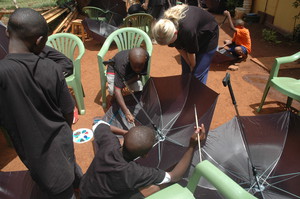Children at Ndugu Mdogo Rescue Learn from Danish Artistes
 Modern art is known as a powerful tool of communication. One drawing can be interpreted in a million dimensions. With all this in mind Jan Lundum an art teacher at Silkeborg Højskole in Denmark made it to Kenya with a delegation of 10 of his students. The mission was clear, to make the vulnerable children communicate their fears and strength through the medium of visual arts and address the need for shelter.
Modern art is known as a powerful tool of communication. One drawing can be interpreted in a million dimensions. With all this in mind Jan Lundum an art teacher at Silkeborg Højskole in Denmark made it to Kenya with a delegation of 10 of his students. The mission was clear, to make the vulnerable children communicate their fears and strength through the medium of visual arts and address the need for shelter.
Visual arts are art forms that create works which are primarily visual in nature. The team’s emphasis was on drawing and painting. Having on black t-shirts labeled Ly- Danish for shelter and Makaazi Swahili for shelter, the team landed in Kibera at Ndugu Mdogo on Saturday October 30. Painting materials, colours and umbrellas filled their bags ready to make the children drill their brains.
“The uniqueness of this exercise is for the children to tell an enticing or troubling story that can be felt within a shelter which is symbolized by the umbrella,” said Lundum.
An emblematical umbrella was used to signify protection through shelter and security. In a swanked ground each child was issued with a black umbrella with instructions to paint inside and outside the cover of the umbrella.
Inside the cover was to express the fears and troubling situations the children had gone through. On the outside the laid colours and drawings were to send a message of the expectation of the children, hopes and future aspiration to be specific.
“This exercise is also aimed at exploring talents from children and their products to be sold at an art exhibition which means that they will not only be dependent on donations from well wishers and the donor community but use their skills to generate money to sustain their livelihoods”, said Lundum.
Patrick Mukambi, a professional artist in Nairobi was part of the exercise that saw over 25 street children holding their brushes for the weekend art practice session. He has been in the industry for 12 years. Although trained as a graphics designer he found his strength on fine art which helps him express his ideas freely to earn him a living. He has worked with many organizations on children projects teaching them on how to be creative and expressing themselves using the art of painting.
“I have been working with this Danish academy for 3 years through painting exercises and studio drawing. The project will run in two phases, where a chorographer will take the children through a short dance piece with the painted umbrellas”, said Mukabi.
Being the facilitator of the day, Mukabi was comfortably throwing the shots of the day’s programme. Children excitement flew over the serene environment. With great anticipation and palpability the children cracked their heads to recall their best and worst moments putting all in a figurative painting.
On his perception about art, Mukabi sated: “I focus on the positive part of life in my art work. No one wakes with their problems written on their faces. No matter the situations one still cracks jokes and moves on with life.”
11 years old Tobia Muide, was keen to bring his fears out in a pictorial. As he sat down to put the paint and brush to work, his undistorted vivid recollection emanated to a sketchy house design. On its side, some inferno pulling the house down.
” I drew the house burning in clear memories of was happened during the post election violence and that’s my greatest fear,”said Muide timidly while scraping the paint brush with his fingers.
The art work will not remain at that, a big exhibition this month in Denmark showcasing the art from Kenya on children rights issue is underway which will run for 2 to 3 months. All the products including the umbrella that were done by the children will be the centre of attraction on the d-day.

“This will bring the Kenyan children and those from Denmark together in their minds. The western world tends to forget that children in need are like their own children that they should protect”, stated Lundum.
James Mweu, the chorographer had something unique for the children; teaching them how to dance and perform some acrobatic spins with the umbrella entirely delivered through juggling, facial expressions and body movements.
“The children are getting the experience of an umbrella which is one artistic displine to a prop in a performance”, said Mweu during the vigorous exercise.
The majority of the street children would not wish to continue with street life and need a better life if given an opportunity. About 77 per cent reported that they would not wish to continue with street life, while only 23 per cent wished to continue with street life. This is according to The African Network for the Prevention and Protection against Child Abuse and Neglect (ANPPCANN) study.



